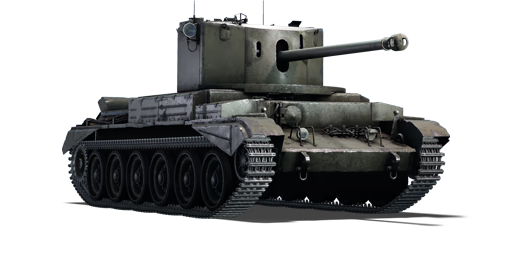



By early 1942, the new 17-pounder anti-tank gun had been developed, and was quickly found to be the most powerful armour-piercing gun of the Allied arsenal. A number of projects were initiated looking to fit the new gun into self-propelled mounts, resulting in designs such as the Sherman Firefly and Achilles. One such project was the A30 Challenger, a medium tank-style design utilising the chassis of the Cromwell; however, compromises had to be made, particularly in the design of the turret to fit the larger gun and an additional crewmember, as well as a lengthening of the hull and reduction in armour, leading to both reduced mobility and protection. Production began in March 1944, and the tank participated in the later stages of the Normandy landings and beyond, operating alongside Cromwells and Shermans to counter the German Tiger I heavy tanks. While the 17-pounder performed to expectations, the tall turret in particular presented a large and weakly armoured target for opposing tanks, though it was still shorter, more mobile, and generally preferred over the Firefly. The Challenger was also issued to Allied forces such as Poland and Czechoslovakia, the latter of which purchased a number of Challengers after the war and operated them until they were scrapped in 1959.
Introduced in Update 1.55 "Royal Armour" along with the initial British ground tree, the main draw of the Challenger is its powerful gun. It is able to easily penetrate any vehicle it may encounter, particularly with the addition of a new, even more penetrating, APDS round to crack the heaviest of targets, allowing it to perform well as a sniper, or as a flanker alongside its reasonable mobility. However, the Challenger should not be used to brawl with opponents: the tank has poor armour protection, a large profile, and terrible reverse speed. It should also be noted that, other than the dedicated HE shell, the ammunition of the 17-pdr still lacks any explosive filler, so critical components such as the crew and ammo racks should be aimed for to maximise the damage potential.
| Ammunition | Type | Armor penetration (mm) at a distance: | |||||
|---|---|---|---|---|---|---|---|
| 10 m | 100 m | 500 m | 1000 m | 1500 m | 2000 m | ||
| AP | 171 | 168 | 155 | 139 | 126 | 113 | |
| HE | 20 | 20 | 18 | 16 | 15 | 13 | |
| APC | 171 | 168 | 155 | 139 | 126 | 113 | |
| APCBC | 190 | 187 | 172 | 155 | 140 | 126 | |
| APDS | 269 | 264 | 246 | 226 | 207 | 189 | |
| Smoke | 3 | 3 | 3 | 3 | 3 | 3 | |
| Belt | Belt filling | Armor penetration (mm) at a distance: | |||||
|---|---|---|---|---|---|---|---|
| 10 m | 100 m | 500 m | 1000 m | 1500 m | 2000 m | ||
| AP/T | 13 | 12 | 7 | 3 | 2 | 0 | |












Mobility | |
|---|---|
Protection |
|---|
Firepower | ||
|---|---|---|